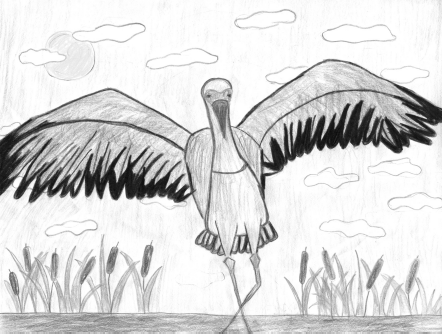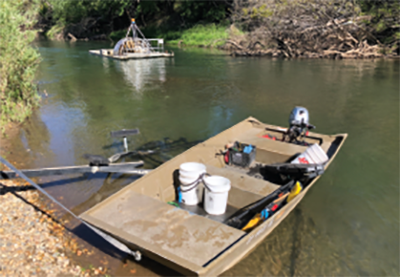Sandhill Crane Spreads its Wings
 SOFIA GUADARRAMA/JOE SERNA JR. CHARTER SCHOOL
SOFIA GUADARRAMA/JOE SERNA JR. CHARTER SCHOOL
 KATHY GRANT/COURTESY PHOTOGRAPH
KATHY GRANT/COURTESY PHOTOGRAPH
Small boat used to inspect a screwtrap, which captures fish for monitoring.
Watershed Education Programs & Videos
Explore the plants and animals that rely on the Mokelumne River, from its origins in the Sierra to its journey into the Delta.
Here, you’ll find an expanding array of programs, activities, and resources designed for local students, teachers, and the community, all centered around the Mokelumne River watershed.
CURRICULUM RESOURCES: The Salmon Connections website has some suggestions on activities you can do with kids.
 SOFIA GUADARRAMA/JOE SERNA JR. CHARTER SCHOOL
SOFIA GUADARRAMA/JOE SERNA JR. CHARTER SCHOOL
 KATHY GRANT/COURTESY PHOTOGRAPH
KATHY GRANT/COURTESY PHOTOGRAPH
Small boat used to inspect a screwtrap, which captures fish for monitoring.
Explore the beauty of nature through a fresh lens with Jay Bell, a seasoned LUSD Science Coach and docent educator.
We invite you to explore the Lodi Lake Walking Tour (Created by WhollyH2O for PocketSights):
Lodi Lake Walking Tour >Upper Mokelumne River watershed forest lumber was key to the success of a Stockton boxmaker who makes wooden boxes used to ship agricultural products all over the world.
Terms: Chemical coagulation, flocculation, sedimentation, filtration, and disinfection.
Terms: Geology, paleochannel, paleowatershed, volcanic material, silica, ash, preservation work, mastodon, ancestral elephants, gomphosphere, Ionic formation.
Animals recovered to date: Elephant-like mastodon with two tusks, gomphothere with 4-tusks, rhinoceros, camel, horse, bird, fish, tortoise, and tapir.
Tour and discover the City of Lodi Water Pollution Control Plant with Kathy Grant and Matt Rempfer.
About 6 hours after a flush in Lodi, the waste water arrives at the plant to have poop and other contaminants removed.
“Fats, Oil, and Grease” = “FOG”; biological process- no chemicals;
Process- Headworks removes rags; primary treatment uses bacteria to eat waste, waste settles out; secondary treatment aerates; tertiary water is “scrubbed” and passes under UV light to disinfect. Checked in the lab, then released for reuse.
Tour Cal-Waste Recovery Systems.
School cafeteria food waste is sorted into 3 categories:
Carts tell the story of where garbage will end up: Blue cart- recycling facility; Black cart- landfill as trash- no reuse; Brown cart- organic waste to composting facility to be land applied.
Kathy Grant interviews Ryan Carrothers - Wildlife Biologist, Sacramento - San Joaquin Delta. The Sandhill Crane migrate to the delta and roost at night during the winter.
Sandhill Cranes migrate through the Pacific flyway to Woodbridge Ecological Preserve in the CA Delta; they are freshwater, riparian wading birds; roost at night in managed and seasonal shallow water.
Mokelumne Watershed - Meet the neighbors of the watershed, people who live or work close to the river.
Watershed communities depend on each other for food, clean water, recreation, education, natural resources, agriculture energy and more.
2023 Coastal Cleanup:
We cannot emphasize enough the importance of individuals taking action to keep our waterways free of trash. In addition, the City of Lodi is committed to meeting state compliance by implementing measures like trash interceptors and street cleaning to protect our precious waterways.
It takes all of us, working together, to keep our waterways clean and healthy!
Watershed Monitoring with James Jones - Wildlife Biologist II, EBMUD discusses threatened species such as the Tiger Salamander in the watershed.
Students from Lodi, board the Marine Research Vessel in the San Francisco Bay and participate with fish trawling and research.
Follow along with student made boats (some with cameras) as they travel through storm drain pipes and make their way to the river.
With Kathy Grant follow storm water from City Hall to Vine Wood basin pump station.
Tour the Mokelumne River Hatchery with Darrick Baker, Hatchery Manager.
Michelle Workman, Manager of fisheries and wildlife, East Bay Mud.
Explore the Chinook Salmon hatchery.
Storm Water Awareness Week 2020 Workshop
Kathy Grant, City of Lodi
PIPP- Storm Drain Detectives Citizen Monitoring
City of Lodi Public Works staff and Lodi teachers monitor the Mokelumne River monthly at 5 sites. pH, nitrates, turbidity, DO, temperature, electrical conductivity, and bacteria.
Lodi Lake Coastal Cleanup - Number 20!
Many people here today have been coming every year, for twenty years to pickup trash along the watershed!
Dr. Stephen Clark, Vice President, Pacific Ecorisk
How does runoff toxicity affect organisms in the watershed?
Dr. Alison McNally, Associate Professor of Geography, CSUS.
Dr. McNally explains various concepts such as Atmospheric rivers and how they form and how Climate Change may contribute.
Tour parts of the beautiful California State University Stanislaus campus.